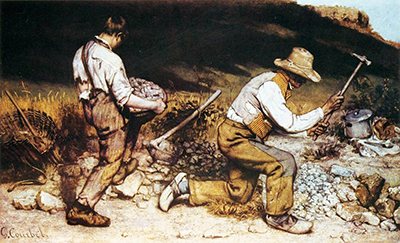Learn more about the life and career of Gustave Courbet in our insightful, comprehensive biography which tracks his rise to fame and the influences which helped to shape his artistic development.
Early Life
Gustave Courbet was born into a farming family, in eastern France. His early knowledge of this rural lifestyle would eventually inspire much of his work. Despite his family's traditional setting, they were still happy to send him off to art colleges as he began to show promise in this area. Perhaps his decision to balance this with studies in Law was enough to retain their backing. Having spent time at both the Collège Royal and the college of Fine Arts in Besançon, this ambitious young man would move onto Paris to continue his development.
Having arrived in the French capital in around 1841, the young student was to gradually concentrate more on his art studies than on his law. The great masters found in the Louvre would be his strongest influence, as they have been for many centuries and to many other artists. His father remained surprisingly supportive and receptive to his son's ambitions, which was perhaps out of character for this period in European history. He clearly held great confidence in his son and even was willing to jeopardise their wealth in order to give him the best chance of success.
Initially it was two famous Spanish painters, Diego Velázquez and José de Ribera, who most pricked the interest of Courbet. He would repeatedly make copies of their original paintings again and again, slowly fine tuning his own technical skills. He was fortunate in being financially supported by his family, and so able to devote his time entirely to art. The Spanish Renaissance had drawn ideas from Italy and the Netherlands, before appending their own ideas and remains highly respected all these centuries later.
Career Development
It was around 1844 that, after several fruitless attempts, Courbet managed to get one of his paintings accepted by the Salon, an important milestone in the career of any French artist at this time. On most occasions the institution found his work to be too bold and unique in order to gain acceptance but his Self Portrait with a Black Dog was deemed to be of a standard and style that they could approve for public display. Towards the late 1840s Courbet was beginning to gain interest and respect for his work, even though his style was still groundbreaking within French art. He continued to build his relationship with the Salon.
The Stonebreakers and Burial at Ornans, two of Courbet's finest paintings, were completed in 1849. His journey back to see his family and re-connect himself with his rural roots appeared to have inspired this period of highly successful work. Having been engulfed in the high energy and selfish life of the city, he was relieved to return to a lifestyle in which he was far more comfortable and it is likely that this happiness allowed his creative mind to work more effectively. These famous artworks drew attention to the lives of the countryside poor and made no attempt to disguise the difficult environment in which they worked. It was a series of realistic depictions, hence the term Realism.
Courbet would now lead the new school of Realism and aimed to draw in inspiration from notable literary figures with whom he was well acquainted. Other than for a trip to Switzerland, the artist remained loyal to his favoured location of Ornans and continued to work from here. 1854 marked the commencement of The Artist's Studio which was one of the artist's most ambitious paintings and also serves as a summary of his life and career. He poignantly turns his back on traditional art in this scene and many other elements of symbolism are used right across this sprawling canvas. Eugene Delacroix, one of the finest Romanticist artists in all art history, wrote about his respect for Courbet's natural talents at around this time.
Courbet would then move to Germany for a short period and continue to spread his idea of how art should be. Many took his lead and were inspired by his decision to stand up to the artistic norms of the time. He continued to depict the beautiful landscape found in and around his home region in France and also produced many notable portraits of women. He also produced a series of seascapes that are believed to have contributed to the development of Impressionism, in part at least. The locations in which he worked included Étretat, Deauville and Trouville. By this stage he was a truly gifted artist with a considerable following and a wide breadth of work behind him.




